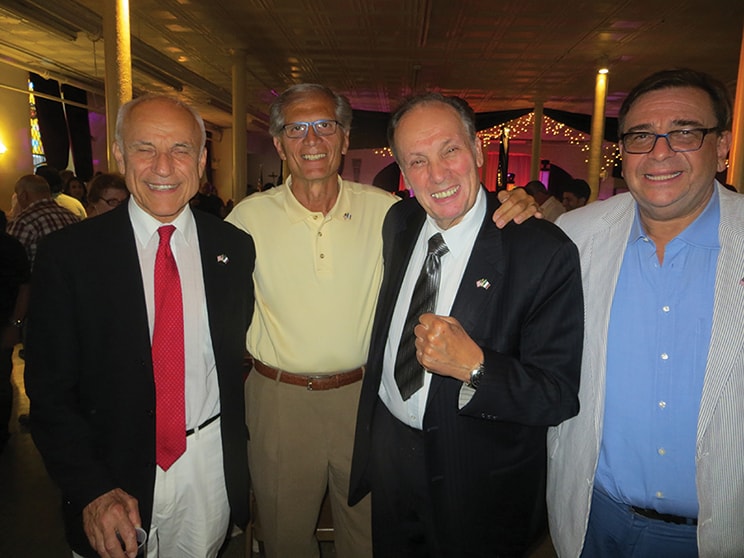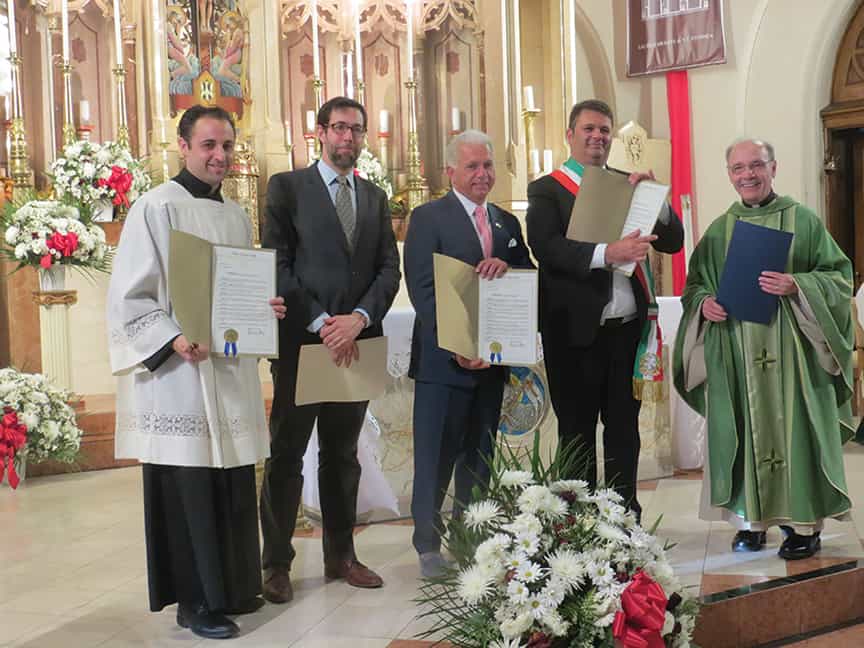Every time I go to Mass at St. Stephen’s Church, I usually find my eyes tearing up midway through the service. There are a number of reasons for this kind of emotional eruption.

The interior’s cathedral height and warm, ivory brightness creates an all too familiar homecoming not just to God, but to its mostly Italian parishioners who have been the stewards and keepers of its long history and existence during my time. I am reminded that while I left, others have stayed; and I miss being a part of its weekly spirit.
Memories of attending mass there with my family, my wedding, or my father’s service as an usher, and later, his funeral, compete for a place in my mind.
Then, there is the band and choir, whose lead singer effectively manages to take an ordinary hymn and lift its soprano range to resounding crescendos which provokes an avalanche of chills to come rushing to the surface.
It wasn’t any different on the afternoon of June 12, when a special 5 o’clock Mass took place for the unveiling of a plaque that was donated by the Van Westerhout Molesi Cittadini Social and Culture Club, and dedicated to St. Stephen’s Church on the occasion of its 150th Anniversary.
This was a particularly important vision and desire of the President of the club, Vito Parente – backed by full member support – who wished to honor the church’s milestone anniversary in a very special way.

He organized a dedication that recognized, but mostly gave thanks, to a church that served a community of immigrants in Red Hook and Carroll Gardens throughout its years.
At the time of its inception, St. Stephen’s served a large Irish immigrant congregation. Sacred Hearts church, founded originally on President Street (with the help of Mother Cabrini) and eventually moved to Hicks and Warren Streets, largely served the huge influx of Italian immigrants that swarmed the Red Hook waterfront area along Columbia Street in the early 1900s. It was demolished for the construction of the BQE.
The diocese’s solution was to merge the congregation of Sacred Hearts with St. Stephen’s, bringing the two groups of immigrants -who had long adapted with living near each other -to also worship side-by-side.
Eventually, the church became a pillar for the Italian immigrants as subsequent generations of Irish-Americans began to journey outside of Red Hook. The maritime industry in Red Hook was at one time heavily populated and owned in part by Irish families . The Red Hook Houses were originally built for the families of Irish and Norwegian immigrants who worked on the piers.
The overturning of the immigration population from Irish to Italian, however, brought a new role for St. Stephen’s. They eventually adopted the patron saint of Mola di Bari, the Addolorata, and hosted many of Mola’s feasts and processions throughout the years, and still do. St. Stephen’s was key to the thriving and then, eventual surviving Molese population.
In a neighborhood that stretched from Atlantic Avenue to the “Point,” there were about eighteen Italian social clubs at one time. Of these, five were Molese Clubs. The Van Westerhout Club remains of the five.
The special Mass
The dedication program started at the end of Mass. The inclusive theme of immigration was passionately revealed through a host of speakers including club members, politicians and even the young Mayor of Mola, Sindaco Giangrazio di Rutigliano.
He traveled to New York for the occasion and was impressed by the depth of Italian influences here.
The church was filled with local families and former parishioners who traveled from afar. Also in attendance, were families from partnering clubs and organizations who recognized the importance of immigration and the integral role any church plays in their assimilation to America.
The audience was reminded by politicians that Brooklyn is still a city of immigrants. Judge Michael Pesce pointed out that 65 of his own years were deeply rooted in St. Stephen’s one hundred and fifty years. He spoke fondly of initiating their club, roughly seventeen of them, on the steps of St. Stephen’s Church.
Back then two masses were said in Italian each Sunday. He recalled seeing the garb of black folds that turned out to be the flowing dress belonging to the statue of Our Lady of Sorrows (the Addolorata) – a core reminder of home.

When the plaque was finally revealed, the mention of its purpose – to remind the next generation of a hard, albeit abundant and grateful past, with the incentive of an even greater, promising future – everyone stood silent to sing “America the Beautiful.” I looked around and saw many people that I knew nodding their heads with understanding. They knew about traveling to a great country to seek a better life, and while still loving and missing their old country, they would never miss an opportunity to pay homage to their new one.
This, to me, is true immigration. Or maybe, as Pino Deserio ,past president of the Molese Club, explained to me, “I came to this country in 1970. In 1980, I became a naturalized citizen, but on 9/11 is when I became a real American in my heart.”
The crowd of about 400 moved downstairs to celebrate the occasion with food and music. Colorful lights were strung. The sandwiches and wine flowed freely. I had a chance to briefly chat with Onofrio, the original owner of House of Pizza and Calzones, who was fond of my father. I met more people with the name “Pietanza” and The Calebs, a seasoned professional band that has long performed for most of the attendees’ various events and weddings, were there to join in the celebration, but only upon singing “God Bless America”, did they begin.
Author
Discover more from Red Hook Star-Revue
Subscribe to get the latest posts sent to your email.










One Comment
great article and mille grazie